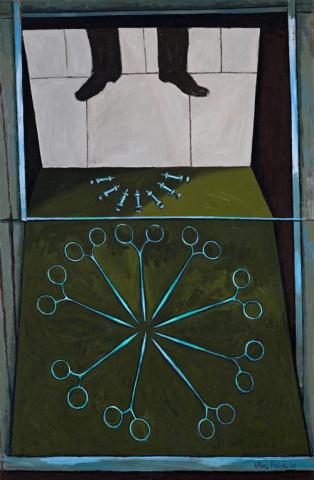THE ROSETTE, 1965
John Brack
81.5 x 53.5 cm
signed and dated lower right: John Brack 65
oil on canvas
Gallery A, Melbourne, 1965 (inscribed verso)
Private collection, New South Wales
Gallery A, Melbourne and Sydney, March - May 1965
The Antipodeans: A Tribute, Kensington Gallery, South Australia, April - May 1968
Grishin, S., The Art of John Brack, Oxford University Press, Melbourne, 1990, vol. I, p. 99 & vol. II, p.20, cat.o147 (illus.)
With their visual ambiguity, stark theatricality and unnerving palette, the 'shop window' paintings which John Brack executed between 1962 and 1968 are among the most highly acclaimed expressions of the artist's exploration of the human condition.
Like the symbolic battlefields of his later pen and pencil tableaux, so too this series- exemplified by The Rosette, 1965, - features inanimate objects as metaphors for people; 'it is a regimented and ordered society, conscious of appearances, but some break ranks and fall or are shown balancing, tottering on the brink of disaster, facing collapse into the abyss below the display case.'1 Merging the interior and exterior of the window, the world of the shopkeeper and the world of the beholder (to whom the suspended feet mirrored here belong), Brack thus creates a stage upon which society performs and is simultaneously reflected, a paradox '...illustrative not only of shop windows, but the whole aspect of life itself. The people who pass by are entangled with the beautiful display of gleaming instruments and they mean not only a paradox but also something to do with the props that hold people together.'2
As a young art student observing the still-life displays of the hardware and machinery shops located near the NGV, Brack had been fascinated by the inherent beauty of unconventional, purely functional objects. Now, more than fifteen years later, he would deliberately employ non-traditional subject matter- artery forceps, artificial lamps, invalid chairs and medical syringes - to challenge notions of 'the aesthetic' and suggest that, '...if beauty results when form follows function, then these objects with forms designed for specific functions generally involved with medicine and healing were also to be considered beautiful.'3
One of the more assured paintings of the series, The Rosette encapsulates well the paradox that ensues from the depiction of objects which may be associated with curing and healing but also, sickness and infirmity. Further irony exists in the distinctly decorative arrangement of the artery forceps in a rosette and small metal syringes in a semi-circle; as the artist himself observes '...you look in the window at all the instruments which are arranged... and it is obvious that somebody loves them, loves them dearly [and] has put them into these patterns, as if they were cosmetics, almost as if they hope that a passerby will be attracted by the display and say 'Ah, I must buy one of those pairs of artery forceps.'4
1. Grishin, S., The Art of John Brack, Oxford University Press, Melbourne, 1990, vol I, p.88
2. Brack in 'John Brack Speaking on his Art', Tony Morphett, ABC TV Documentary, 1965, p.2
3. Grishin, op.cit.
4. Brack, op.cit.
VERONICA ANGELATOS
